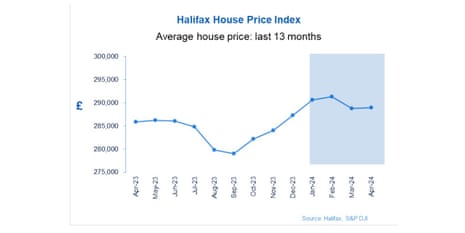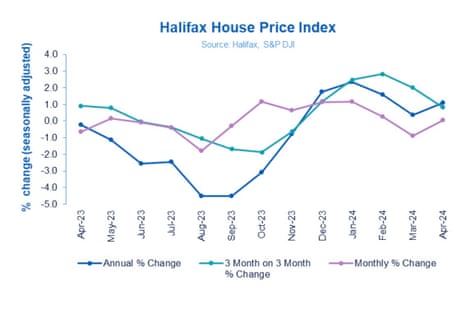Introduction: Halifax reports small rise in UK house prices
Good morning, and welcome to our rolling coverage of busines, the financial markets and the world economy.
Another day, another healthcheck on the UK housing sector.
And this morning, lender Halifax have reported that the market is “finding its feet” in the face of higher borrowing costs.
Halifax’s monthly gauge shows that average house price rose by +0.1% in April on a monthly basis, after a fall of 0.9% in March.
On an annual basis, prices were 1.1% higher than in April 2023 – a time when house price growth was weaker.

This has lifted the average price to £288,949, slightly higher than the £288,781 in March, with growth fastest in Northern Ireland.
This contrasts with rival lender Nationwide, which reported last week that prices dipped by 0.4% in April.
Amanda Bryden, head of mortgages at Halifax, says the average house prices have “largely plateaued” in the early part of 2024, adding:
“This reflects a housing market finding its feet in an era of higher interest rates. While borrowing costs remain more expensive than a few years ago, homebuyers are gaining confidence from a period of relative stability.
Activity and demand is improving, evidenced by greater numbers of mortgage applications so far this year, while at an industry level mortgage approvals have reached their highest point in 18 months.
Bryden adds that first-time buyers have been compensating for higher borrowing costs by targeting smaller properties. That has left to the prices of flats rising faster than larger properties in 2024.

The agenda
-
7am BST: German trade balance for March
-
8.30am BST: Eurozone construction PMI for April
-
9am BST: UK new car sales for April
-
9.30am BST: UK construction PMI for April
-
10am BST: Business and Trade Committee hearing on good work and protecting workers’ rights
-
1.30m BST: BoE policymaker Jonathan Hall gives a speech at the University of Exeter about artificial intelligence, titled ‘Monsters in the deep ….’
Key events
UK construction growth hits 14-month high, but housebuilding stumbles
Just in: UK construction sector growth has hit a 14-month high, despite a drop in housebuilding.
Data firm S&P Global reports that the UK construction sector gained momentum last month, due to solid rates of expansion in the commercial and civil engineering segments.
This pushed the S&P Global UK Construction Purchasing Managers’ Index, which measures activity, up to 53.0 in April, from 50.2 in March. That’s the highest reading since February 2023, further from the 50-point mark that shows stagnation.
But, the survey also shows a “setback” for house building activity, where the sub-index dropped to 47.6.
The data suggests “a moderate fall in residential building work”, with builders blaming sluggish market conditions and higher borrowing costs.
Tim Moore, economics director at S&P Global Market Intelligence, says:
Lacklustre market conditions in the house building segment continued to weigh on activity. The latest survey pointed to the fastest reduction in residential building work since January, although the speed of the downturn remained much softer than in the second half of 2023.
Hiring trends were subdued in April despite a recovery in workloads, which mirrored trends seen in other part of the UK economy, as construction firms sought to maintain a tight focus on costs against a backdrop of strong wage pressures. Purchasing prices nonetheless increased only modestly in April.
Consumer demand for battery-powered cars drops
Car sales to UK private buyers fell in April, as demand for vehicles weakened and sales of electric cars to consumers fell.
Industry body SMMT has reported that overall UK new car registrations grew for the 21st consecutive month in April, rising by 1.0% to 134,274 units.
But, that growth was entirely due to sales to fleet operators (such as car rental firms). While fleet registrations jumped by 18.5%, there was a 17.7% drop in sales to private buyers and a 16.1% drop in registrations to businesses
The SMMT reports that electrified vehicles were the main drivers of market expansion again.
Sales of plug-in hybrids (PHEVs) rose by 22.1% year-on-year, followed by hybrid electric vehicles (HEVs) which gres by 16.7%. Sales of battery-powered electric vehicle (BEVs) rose by 10.7%.
Electrified vehicles continued to be the main drivers of market expansion
🔌PHEVs recorded the strongest growth, rising by 22.1% to account for 7.8% of the market
⚡️HEVs, up 16.7% with a 13.1% share of demand
🔋 BEV uptake rose 10.7%, pushing up market share to 16.9%, a… pic.twitter.com/ALGq8uTF0M— SMMT (@SMMT) May 7, 2024
But, the increased sales of BEVs was entirely due to business buyers, with sales to consumers falling by almost 22%.
The SMMT says:
While the overall increase in BEV demand is positive, urgent action is needed to re-enthuse private buyers into switching….
Drivers today enjoy the widest ever choice of BEV models – more than 100 – powered by the latest technology, and manufacturers continue to provide compelling offers to encourage their uptake. However, the lack of government incentives for private motorists remains a barrier that cannot be overcome by industry alone.
📢”Although attractive deals on EVs are in place, manufacturers cannot fund the mass market transition single-handedly. Temporarily cutting VAT, treating EVs as fiscally mainstream not luxury vehicles, and taking steps to instil consumer confidence in the chargepoint network will… pic.twitter.com/yBYg80mszi
— SMMT (@SMMT) May 7, 2024
House prices: What the experts say
The small increase in UK house prices in April has left them broadly flat since the turn of the year, says Peter Arnold, EY UK chief economist:
The stabilisation in market conditions reflects the large fall in mortgage rates since last summer, with transactions and prices appearing to have passed their trough.
However, the recent rise in mortgage rates is likely to dampen the recovery in the short-term. And looking ahead, the recovery in prices is unlikely to be rapid given that poor affordability continues to significantly limit the pool of potential buyers and mortgage rates are only likely to fall back slowly.
Tom Bill, head of UK residential research at Knight Frank says higher mortgage rates are continuing to hit market momentum, adding:
As the prospect of the first rate cut since March 2020 drifts further into the distance, borrowing costs have edged higher and budgets have been squeezed.
A short-lived burst of positivity in the early weeks of this year led to higher supply, increasing downwards pressure on prices. A wave of homeowners currently rolling off sub-2% mortgages is adding to the financial pressures in the system. As a summer rate cut moves onto the horizon, we expect UK house prices to respond and rise by 3% in 2024.”
The recent increases in mortgage rates could lead to market volatility this year, warns Mark Harris, chief executive of mortgage broker SPF Private Clients:
“Borrowers have benefited from cheaper mortgage rates since the start of the year, which has boosted market activity and enquiries.
“Since then, higher funding costs have led to higher mortgage rates over the past couple of weeks and there is likely to be some volatility in pricing ahead. Borrowers would be wise to secure a rate they like the look of to protect themselves from further price fluctuations in the short term.
“Once the Bank of England is confident inflationary pressures have eased and starts cutting interest rates, this will provide a welcome boost for the market and should help increase confidence and activity.”
Nicky Stevenson, managing director at estate agent group Fine & Country, suggests a cut in interesst ratesr would help the market:
“House prices are yo-yoing as buyers and sellers negotiate their way through the uncertain economy, with a small monthly rise in April.
“Consumers are expecting a fall in interest rates at some point this year. But with lenders increasing rates in the last few weeks, buyers have understandable hesitancy over the right price to offer, while sellers are trying to navigate how offers align with their expectations.
“Yet despite this confusion over pricing, demand is holding up well, with mortgage approvals continuing to rise and supply levels improving.
“All attention turns to the Bank of England, as a fall in the base rate this week would help to solidify confidence in the housing market.”
However, the City don’t expect the BoE to cut rates at its meeting on Thursday – the first cut is currently fully priced in for August.
Victoria Scholar, head of investment at interactive investor, explains:
It looks like mortgage rates will continue to remain elevated with the Bank of England poised to keep interest rates at 16-year highs of 5.25% this Thursday.
Financial markets have been pushing back their forecasts for the timing of the first rate hike this year, with August currently pencilled into the diary, although that could certainly change depending on the data.”
German factory orders drop unexpectedly
Over in Germany, manufacturing orders have dropped unexpectedly…. but exports are improving.
New data shows that German factory orders dropped by 0.4% in March, missing forecasts for a rise of 0.4%.
Orders for new cars rose by 1.1%, but orders for ”other transport equipment” such as aircraft, ships, and trains fell by 2.3% month on month.
Orders for fabricated metal products fell by 4.5%, but electrical equipment orders were up 5.9%.
Good Morning from Germany where factory orders unexpectedly dropped in March, 3rd drop in a row, pointing to persistent weakness in a sector already lagging behind the improvement in the wider economy. Feb’s reading was also revised down to a 0.8% decrease https://t.co/1jdRPslsn0 pic.twitter.com/bzSA7ieOnf
— Holger Zschaepitz (@Schuldensuehner) May 7, 2024
But, statistics body Destatis have also reported that German exports picked up by 0.9% in March, rising faster than imports (which were up 0.3%).
This “confirms the return of the export-driven German growth model’, says Carsten Brzeski, global head of macro at ING, who is also concerned that industrial orders remain weak.
Brzeski writes:
The share of exports to the US increased to more than 10% of total exports in 2023, while the share of exports to China dropped to 6%, significantly below pre-pandemic levels. At the same time, Germany exported more to Poland, the Czech Republic and Hungary than to the US.
However, banking on a return of the well-known success formula of the export-oriented growth model would be deceptive. The long list of geopolitical risks, potential trade tensions and increasing global competition should provide sufficient arguments against policy complacency. The German economic business model still needs to be much more balanced.
To some extent, industrial orders this morning illustrated the high risk that the revival of the export-oriented success formula is only short-lived. In fact, after the first post-lockdown recovery, demand for German manufacturing goods has been weak. In fact, since the start of 2022, industrial orders have dropped on average by 0.5% every month.
Commuters who are forced to work from home today due to the rail strikes can take comfort that at least the weather has improved, after some damp and chilly weeks (months?).
That cold, wet weather has been bad news for retailers and restaurants this spring, the latest industry figures show.
Sales were virtually flat across March and April against the same period a year ago, according to the latest figures from the British Retail Consortium (BRC) trade body and advisory firm KPMG. That was despite prices continuing to rise with inflation, suggesting a drop in the volume of items sold in the key Easter period.
FTSE 100 hits new intraday high
Boom! Britain’s FTSE 100 share index has hit a fresh alltime high at the start of trading in London.
The Footsie has extended its recent rally, jumping by over 1.1% to hit 8311 points, a new intraday high.
Traders are hitting their buy buttons as they return to their desks after the Bank Holiday break, catching up with a rally on Wall Street last night….
…. those traders who managed to reach their desks, anyway, given trains on some of the busiest commuter routes in the country are not running today, due to strike action.
Saudi Arabia’s energy giant Aramco has just released its latest financial results, and like BP they show a drop in earnings in the last quarter.
Here’s the details:
-
Net income: $27.3bn (Q1 2023: $31.9bn)
-
Cash flow from operating activities: $33.6bn (Q1 2023: $39.6bn)
-
Free cash flow: $22.8bn (Q1 2023: $30.9bn)
Income before income taxes and zakat fell to $54.67bn in the quarter, down from $61.12bn in the first three months of 2023.
Saudi Aramco says:
The decrease was primarily a result of lower crude oil volumes sold, weakening refining and chemicals margins, and lower finance and other income.
This was partially offset by lower production royalties and an increase in crude oil prices compared to the same period last year.
Global Witness: BP shareholders enriched by £22.3bn since invasion of Ukraine
Campaign group Global Witness have calculated that BP shareholders have received “a staggering £22.3bn” since the invasion of Ukraine in February 2022.
Those payments have come through dividends – which BP raised by 10% last year – and through share buybacks, in which BP uses case to buy back and cancel shares, a process which lifts its share prices.
Alice Harrison, Head of Fossil Fuel Campaigns at Global Witness, says:
“These past two years have inflicted untold misery and pain on the people of Ukraine, while big energy firms that spent years doing business with Putin’s Russia have seen the cash roll in.”
It’s obscene that anyone would profit from the Ukraine war, the energy crisis, or the climate crisis, but that’s what’s happening. With the biggest spoils going to one of the richest, most destructive industries in the world – the fossil fuel industry.”
“Instead of helping to rebuild Ukraine, ease the burden of high bills or support countries suffering from the climate crisis, BP is making the rich richer. And this will continue to be the case until we make the urgent switch to a clean energy system.”
The regional picture
Halifax’s UK house price report shows that annual price falls are predominately found in the south of England, maintaining the ‘North-South’ divide across English regions.
The North West of England continues to see the strongest growth in England, with average prices up by 3.3% on an annual basis to £231,599.
Prices in London are pretty flat over the last year up just 0.1% (with the average at £539,336).
Properties in Eastern England recorded the biggest decline of -1.1%, with homes selling for an average of £329,723, a drop of £3,541 over the last year.
Northern Ireland remains the strongest performing nation or region in the UK, with house prices up by 3.4% over the last year (taking the average to £192,502))
In Wales annual property price growth slowed to +1.1% in April, while prices in Scotland are up 1.5% year-on-year.
According to lender @HalifaxBank the typical UK home found an extra £200 down the sofa, rising 0.1% on last month to £288,949. Annually they increased by 1.1% but this was largely due to weak growth the year before.
Ireland (3.4%) Scotland (+1.5%) Wales (1.1%) & North west… pic.twitter.com/AbcRdUZdoj— Emma Fildes (@emmafildes) May 7, 2024
Halifax: We now expect property prices to rise modestly this year
Despite average house prices inching up in April, Halifax adds that affordability constraints are still a significant challenge.
That applies to new buyers, and also borrowers who are rolling off fixed-term deals, and facing a jump in repayment costs.
Amanda Bryden, Halifax’s head of mortgages, says interest rate cuts later this year should help borrowers:
Mortgage rates have edged up again in recent weeks, primarily as a result of expectations around future Bank of England base rate changes, with markets now pricing in a slower pace of cuts.
If, as is still expected, downward moves in Bank Rate come into play later this year, fixed mortgage rates should fall. Combined with the resilience displayed by the housing market over recent months, we now expect property prices to rise modestly over the course of 2024.”
BP profits miss forecasts as oil and gas trading weakens
In the oil sector, energy giant BP has missed profit forecasts this morning.
BP has reported a drop in profits, with underlying earnings falling to $2.7bn in the first quarter of 2024, down from $2.9bn in the final quarter of 2024.
That’s below analysts forecasts for profits of $2.9bn, and sharply lower than the $4.9bn BP made in Q1 2023, when oil and gas prices were higher.
BP says the drop in profits was due to weaker oil and gas trading, “significantly weaker” profit margins at its fuels division, and the disruption at its Whiting refinery outage in northwest Indiana which shut down for several weeks due to a power outage.
But despite this drop in profits, BP is continuing to pump money to shareholders. It has annouced a new $1.75bn share buyback this morning.
Kate Thomson chief financial officer at BP, says:
bp reported solid financial performance in the first quarter with adjusted EBITDA* of $10.3 billion and underlying replacement cost profit of $2.7 billion.
Our financial frame is unchanged, and we are delivering competitive shareholder distributions, announcing a $1.75 billion share buyback for the first quarter as part of our commitment of $3.5 billion for the first half of 2024.
Introduction: Halifax reports small rise in UK house prices
Good morning, and welcome to our rolling coverage of busines, the financial markets and the world economy.
Another day, another healthcheck on the UK housing sector.
And this morning, lender Halifax have reported that the market is “finding its feet” in the face of higher borrowing costs.
Halifax’s monthly gauge shows that average house price rose by +0.1% in April on a monthly basis, after a fall of 0.9% in March.
On an annual basis, prices were 1.1% higher than in April 2023 – a time when house price growth was weaker.
This has lifted the average price to £288,949, slightly higher than the £288,781 in March, with growth fastest in Northern Ireland.
This contrasts with rival lender Nationwide, which reported last week that prices dipped by 0.4% in April.
Amanda Bryden, head of mortgages at Halifax, says the average house prices have “largely plateaued” in the early part of 2024, adding:
“This reflects a housing market finding its feet in an era of higher interest rates. While borrowing costs remain more expensive than a few years ago, homebuyers are gaining confidence from a period of relative stability.
Activity and demand is improving, evidenced by greater numbers of mortgage applications so far this year, while at an industry level mortgage approvals have reached their highest point in 18 months.
Bryden adds that first-time buyers have been compensating for higher borrowing costs by targeting smaller properties. That has left to the prices of flats rising faster than larger properties in 2024.
The agenda
-
7am BST: German trade balance for March
-
8.30am BST: Eurozone construction PMI for April
-
9am BST: UK new car sales for April
-
9.30am BST: UK construction PMI for April
-
10am BST: Business and Trade Committee hearing on good work and protecting workers’ rights
-
1.30m BST: BoE policymaker Jonathan Hall gives a speech at the University of Exeter about artificial intelligence, titled ‘Monsters in the deep ….’












